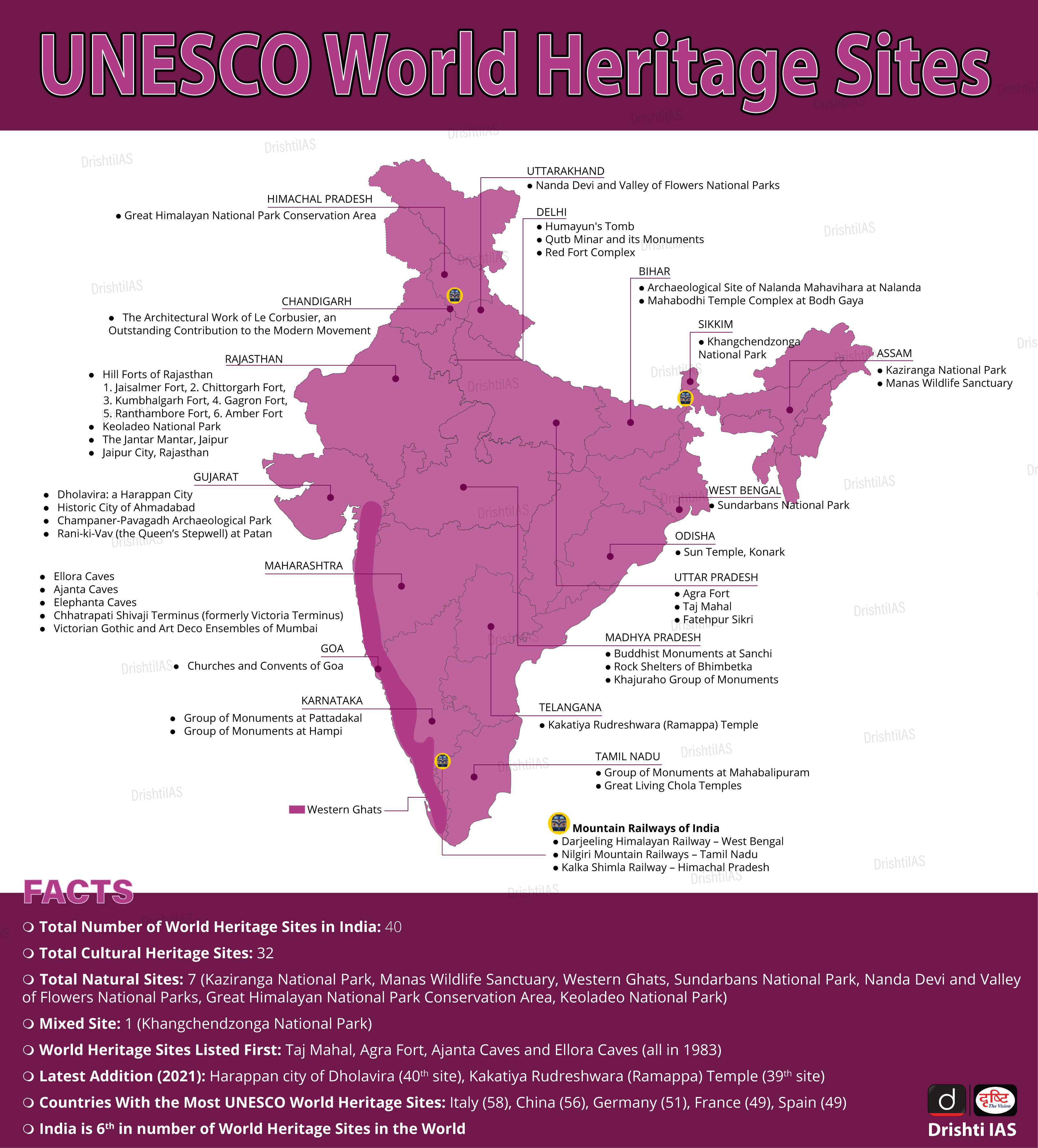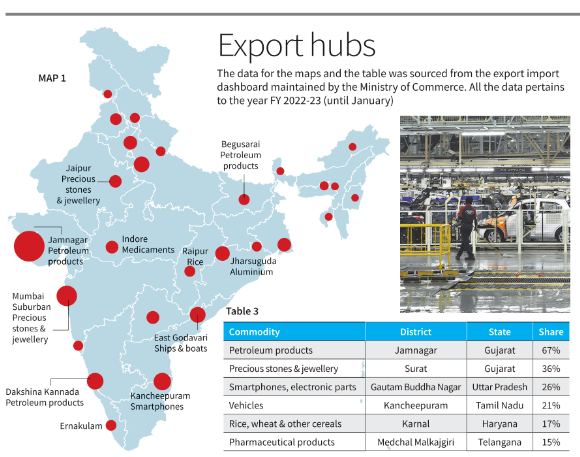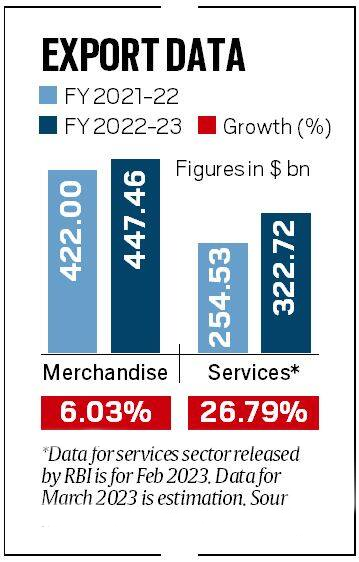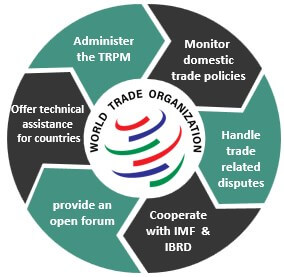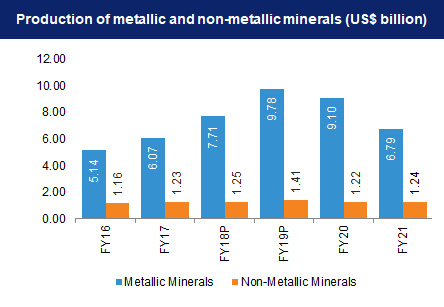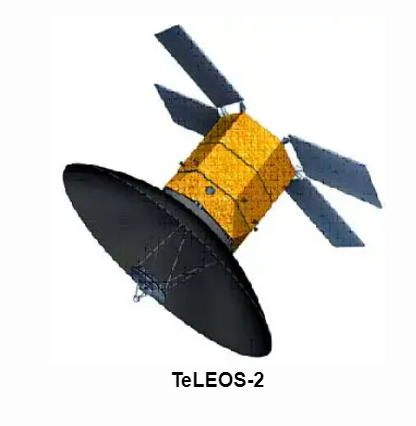Indian Heritage & Culture
World Heritage Day
For Prelims: International Council on Monuments and Sites (ICOMOS), World Heritage Day,UNESCO World Heritage Sites, Khangchendzonga National Park, Indian National Trust for Art & Cultural Heritage (INTACH), Geographic Information System, Remote Sensing
For Mains: Status of Heritage Sites in India, Heritage Influence on India’s Cultural Identity, Issues Related to Heritage Management in India.
Why in News?
The International Council on Monuments and Sites (ICOMOS) declared April 18th as the International Day for Monuments and Sites, also known as World Heritage Day, in 1982.
- The theme for this year is "Heritage Changes," which focuses on the role of cultural heritage in climate action and its importance in protecting vulnerable communities.
What is the Status of Heritage Sites in India?
- About:
- India is currently home to 40 UNESCO World Heritage Sites, making it the country with the sixth-largest number of sites in the world.
- Out of these, 32 are cultural sites, 7 are natural sites, and one is a mixed-type site, the Khangchendzonga National Park.
- The cultural heritage sites in India include ancient temples, forts, palaces, mosques, and archaeological sites that reflect the rich history and diversity of the country.
- The natural heritage sites in India include national parks, wildlife reserves, and natural landscapes that showcase the country's unique biodiversity and ecological significance.
- The mixed-type site in India, the Khangchendzonga National Park, is known for its cultural significance as well as its biodiversity, as it is home to several rare and endangered species.
- Constitutional and Legislative Provisions Related to Indian Heritage:
- Directive Principles of State Policy: Article 49 puts obligation on the State to protect every monument or place or object of artistic or historic interest, declared by or under law made by Parliament to be of national importance.
- Fundamental Duty: Article 51A of Constitution states that it shall be the duty of every citizen of India to value and preserve the rich heritage of our culture.
- Ancient Monuments and Archaeological Sites and Remains Act (AMASR Act) 1958: It is an act of the Parliament of India that provides for the preservation of ancient and historical monuments and archaeological sites and remains of national importance, for the regulation of archaeological excavations and for the protection of sculptures, carvings and other like objects.
- Heritage Influence on India’s Cultural Identity:
- StoryTellers of India’s Glory: Heritage is the legacy of physical artefacts and intangible attributes of society that are inherited from past generations, maintained in the present, and preserved for the benefit of future generations.
- Reflection of Unity in Diversity: India is a museum of different types, communities, customs, traditions, religions, cultures, beliefs, languages, castes and social system.
- But even after having so much external diversity, in Indian culture there is Unity in Diversity.
- Tolerating Nature: Indian society gave every culture the opportunity of prospering that is reflected in its diverse heritage. It does not try to suppress diversity in favour of uniformity.
- Issues Related to Heritage Management in India:
- Lack of Centralised Database for Heritage Sites: India lacks a complete national level database with state wise distribution of heritage structure.
- Indian National Trust for Art & Cultural Heritage (INTACH) has inventoried about 60,000 buildings in around 150 cities which is still only the tip of the iceberg as there are estimated more than 4000 heritage towns and cities in the country.
- Outdated Mechanism of Excavation and Exploration: Due to the prevalence of outdated mechanisms, Geographic Information System and Remote Sensing are rarely used in exploration.
- Also, local bodies involved in urban heritage projects are often not equipped enough to handle heritage conservation.
- Environmental Degradation and Natural Disasters: Heritage sites in India are vulnerable to environmental degradation and natural disasters, such as pollution, erosion, flooding, and earthquakes, which can cause irreversible damage to their physical structures and cultural significance.
- For example, the Taj Mahal in Uttar Pradesh, a UNESCO World Heritage Site and an iconic symbol of India's cultural heritage, has faced challenges due to air pollution, which has caused yellowing and deterioration of its marble.
- Unsustainable Tourism: Popular heritage sites in India often face high tourism pressure, which can result in issues such as overcrowding, unregulated visitor activities, and inadequate visitor management.
- Uncontrolled tourism can cause damage to heritage structures, impact the local environment, and disrupt the local community's way of life.
- Lack of Centralised Database for Heritage Sites: India lacks a complete national level database with state wise distribution of heritage structure.
- Recent Government Initiatives Related to Heritage Conservation:
Way Forward
- Sustainable Funding Models: Exploring and implementing innovative funding models for heritage conservation, such as public-private partnerships, corporate sponsorships, crowdfunding, and community-based funding.
- This can help generate additional financial resources for heritage sites and ensure their sustainable conservation and maintenance.
- Example: Encouraging corporate sponsorships for specific conservation projects, where companies can contribute funds and resources in exchange for brand recognition and promotional opportunities.
- Technology- enabled Conservation: Leveraging advanced technologies such as remote sensing, 3D scanning, virtual reality, and data analytics for documentation, monitoring, and conservation of heritage sites.
- This can enable more efficient and effective heritage management practices, including condition assessment, preventive conservation, and virtual tourism experiences.
- Example: Using 3D scanning and virtual reality to create digital replicas of heritage structures, which can be used for virtual tours, educational purposes, and as a reference for restoration and conservation work.
- Innovative Measures to Increase Engagement: Monuments that do not attract a large number of visitors and those which have no associated cultural/religious sensitivity should be used as venues for cultural programmes with the twin objectives:
- Promoting the associated intangible heritage
- Increasing visitor numbers to such sites.
UPSC Civil Services Examination, Previous Year Question (PYQ)
Q.1 Safeguarding the Indian Art Heritage is the need of the moment. Discuss. (2018)
Q.2 Indian Philosophy and tradition played a significant role in conceiving and shaping the monuments and their art in India. Discuss. (2020)
Buy Now
Economy
India’s Export Capabilities
For Prelims: Top Exporting District in India, Mega Integrated Textile Region and Apparel (MITRA) Park, Russia-Ukraine War, Industry 4.0 technologies, Space, Semiconductor, Solar energy
For Mains: Status of the Export Sector in India, Challenges Related to the Export Sector.
Why in News?
Jamnagar in Gujarat is the top exporting district in India. It formed about 24% of India's exports in value terms in FY23 (till January).
- Surat in Gujarat and Mumbai Suburban in Maharashtra feature second and third by a distance, forming only about 4.5% of the country's exports in the period.
- The other districts in the top 10 are Dakshina Kannada (Karnataka), Devbhumi Dwarka, Bharuch and Kachchh (Gujarat), Mumbai (Maharashtra), Kancheepuram (Tamil Nadu) and Gautam Buddha Nagar (Uttar Pradesh).
What is the Status of the Export Sector in India?
- Status of Trade:
- The merchandise trade deficit, which is the gap between exports and imports, increased by over 39% in 2022-23 to record USD 266.78 billion, as compared to USD 191 billion in 2021-22.
- Merchandise imports increased by 16.51% in 2022-23, while merchandise exports rose by 6.03%.
- Overall trade deficit, however, stood at USD 122 billion in 2022-23, as compared to USD 83.53 billion in the 2022, gaining support from trade surplus in services.
- India’s Major Export Arenas:
- Engineering Goods: They registered a 50% growth in exports, at USD 101 bn in FY22.
- Currently, all pumps, tools, carbides, air compressors, engines, and generators manufacturing MNC companies in India are trading at all-time highs and shifting more production units to India.
- Agriculture Products: Agricultural exports were buoyed by the government's push to meet global demand for food amid the pandemic. India exports rice worth USD 9.65 bn, the highest among agricultural commodities.
- Textile and Apparels: India’s textile and apparel exports (including handicrafts) stood at USD 44.4 billion in FY22, a 41% increase on a YoY basis.
- Government’s scheme like Mega Integrated Textile Region and Apparel (MITRA) Park are giving a strong boost to this sector.
- Engineering Goods: They registered a 50% growth in exports, at USD 101 bn in FY22.
- Pharmaceuticals and Drugs: India is the third-largest producer of medicines by volume and the biggest supplier of generic drugs.
- India supplies over 50% of Africa’s requirement for generics, around 40% of generic demand in the US and 25% of all medicine in the UK.
- Challenges Related to Export Sector:
- Access to Finance: Access to affordable and timely finance is crucial for exporters.
- However, many Indian exporters face challenges in obtaining finance due to high interest rates, collateral requirements, and lack of credit availability from financial institutions, particularly for small and medium-sized enterprises (SMEs).
- Limited Diversification of Exports: India's export basket is concentrated in a few sectors, such as engineering goods, textiles and pharmaceuticals, which makes it vulnerable to global demand fluctuations and market risks.
- Limited diversification of exports poses a challenge to India's export sector as it can limit its resilience to changing global trade dynamics.
- Rising Protectionism and Deglobalisation: Countries around the globe are moving towards protectionist trade policies due to disrupted global political order (Russia-Ukraine War) and weaponization of supply chain, that is in way shrinking India’s export capacities.
- Access to Finance: Access to affordable and timely finance is crucial for exporters.
Way Forward
- Investment in Infrastructure: Improved infrastructure and logistics are critical for enhancing export competitiveness.
- India should prioritise investments in transportation networks, ports, customs clearance processes, and export-oriented infrastructure such as export promotion zones and specialised manufacturing zones.
- This can reduce transportation costs, improve supply chain efficiency, and boost export capabilities.
- Skill Development and Technology Adoption: Skill development programs should be implemented to enhance the availability of skilled labour in export-oriented industries.
- Additionally, incentivizing and promoting technology adoption, such as automation, digitization, and Industry 4.0 technologies, can boost productivity, competitiveness, and innovation in the export sector.
- Exploring Joint Development Programmes: Amidst a wave of deglobalisation and slowing growth, exports cannot be the sole engine of growth.
- India can also explore joint development programmes with other countries in sectors like space, semiconductor, solar energy to improve India’s medium-term growth prospects.
UPSC Civil Services Examination, Previous Year Questions (PYQs)
Q1. Increase in absolute and per capita real GNP do not connote a higher level of economic development, if (2018)
(a) Industrial output fails to keep pace with agricultural output.
(b) Agricultural output fails to keep pace with industrial output.
(c) Poverty and unemployment increase.
(d) Imports grow faster than exports.
Ans: (c)
Q2. The SEZ Act, 2005 which came into effect in February 2006 has certain objectives. In this context, consider the following: (2010)
- Development of infrastructure facilities.
- Promotion of investment from foreign sources.
- Promotion of exports of services only.
Which of the above are the objectives of this Act?
(a) 1 and 2 only
(b) 3 only
(c) 2 and 3 only
(d) 1, 2 and 3
Ans: (a)
Q3. A “closed economy” is an economy in which (2011)
(a) the money supply is fully controlled
(b) deficit financing takes place
(c) only exports take place
(d) neither exports or imports take place
Ans: (d)


Economy
WTO Panel Rules Against India
For Prelims: WTO, European Union, Protectionism, ITA.
For Mains: WTO Panel Rules Against India.
Why in News?
Recently, a World Trade Organization (WTO) Panel has ruled against India in a dispute over information technology (IT) tariffs with the European Union (EU) and other countries.
What are the Key Highlights?
- Background:
- India has been looking to promote domestic IT manufacturing and reduce its dependence on imports, but this approach has been challenged by the EU and other countries, who argue that such measures are Protectionist and violate Global Trade Rules.
- In 2019, the EU challenged India's introduction of import duties of between 7.5% and 20% for a wide range of IT products, such as mobile phones and components, as well as integrated circuits, saying they exceeded the maximum rate.
- Japan and Taiwan also complained the same.
- Ruling:
- The panel found that India's tariffs on certain IT products violated global trading rules, as they were inconsistent with the terms of the Information Technology Agreement (ITA).
- The ITA is a global trade agreement that aims to eliminate tariffs on a wide range of IT products. India is signatory to the 1996 ITA.
- The ruling has highlighted the need for India to align its trade policies with global norms and obligations.
- It also underscores the challenges that developing countries like India face in balancing their domestic policy objectives with their international trade commitments.
- The panel found that India's tariffs on certain IT products violated global trading rules, as they were inconsistent with the terms of the Information Technology Agreement (ITA).
- India’s Argument:
- India argued that at the time of signing the ITA, products such as smartphones did not exist and hence, it was not bound to eliminate tariffs on such items.
- Implications:
- According to the European Commission, the EU is India's third-largest trading partner, accounting for 10.8% of total Indian trade in 2021.
- The WTO ruling against India may have significant implications for trade relations between India and the EU, as well as Japan and Taiwan.
- India may be required to lower or eliminate the import duties that were challenged by the EU and other countries. This could have an impact on India's domestic manufacturing sector, which has been protected by such tariffs.
What Options does India have after the WTO ruling?
- India has a choice to appeal against the WTO ruling over IT tariffs, but if India Appeals the case will be held in Legal Purgatory.
- This is because the WTO's top appeals bench is no longer functioning due to the US opposition to judge appointments.
- Legal purgatory is used to describe a situation where a legal case or dispute is in a state of limbo, without resolution or a clear path forward.
- This situation can be particularly challenging for countries that are seeking to resolve trade disputes in a transparent and rules-based manner, as it undermines the effectiveness of the WTO's dispute settlement mechanism.
What is the World Trade Organization (WTO)?
- About:
- It came into being in 1995. The WTO is the successor to the General Agreement on Tariffs and Trade (GATT) established in the wake of the Second World War.
- Its objective is to help trade flow smoothly, freely and predictably.
- It has 164 members, accounting for 98% of world trade.
- It was developed through a series of trade negotiations, or rounds, held under the GATT.
- GATT is a set of multilateral trade agreements aimed at the abolition of quotas and the reduction of tariff duties among the contracting nations.
- The WTO’s rules – the agreements – are the result of negotiations between the members.
- The current set is largely the outcome of the 1986- 94 Uruguay Round negotiations, which included a major revision of the original GATT.
- The WTO Secretariat is based in Geneva (Switzerland).
- It came into being in 1995. The WTO is the successor to the General Agreement on Tariffs and Trade (GATT) established in the wake of the Second World War.
- WTO Ministerial Conference:
- It is the WTO’s top decision-making body and usually meets every two years.
- All members of the WTO are involved in the MC, and they can take decisions on all matters covered under any multilateral trade agreements.
- Concerns:
- WTO’s top Appeals Officials are no longer functioning because of the US opposition to judge appointments.
- The current situation highlights the challenges that the WTO faces in resolving trade disputes in the current global context, where countries are increasingly adopting protectionist measures and challenging the rules-based international trading system.
UPSC Civil Services, Previous Years Questions (PYQ)
Q. Consider the following statements: (2017)
- India has ratified the Trade Facilitation Agreement (TFA) of WTO.
- TFA is a part of WTO’s Bali Ministerial Package of 2013.
- TFA came into force in January 2016.
Which of the statements given above is/are correct?
(a) 1 and 2 only
(b) 1 and 3 only
(c) 2 and 3 only
(d) 1, 2 and 3
Ans:(a)
Exp:
- Trade Facilitation Agreement (TFA) was negotiated at the 2013 Bali Ministerial Conference. Hence,statement 2 is correct.
- It entered into force on 22 February 2017 following its ratification by two-thirds of the WTO members. Hence, statement 3 is not correct.
- India had ratified TFA in 2016. Hence, statement 1 is correct.
- The TFA contains provisions for expediting the movement, release and clearance of goods, including goods in transit. It also sets out measures for effective cooperation between customs and other appropriate authorities on trade facilitation and customs compliance issues. It further contains provisions for technical assistance and capacity building in this area.
- Therefore, option (a) is the correct answer.
Buy Now
Governance
Ninth Schedule of Constitution
For Prelims: Reservation, Constitution (First Amendment) Act, 1951.
For Mains: Ninth Schedule of the Constitution.
Why in News?
Recently, the Chhattisgarh Chief Minister wrote to the Prime Minister seeking the inclusion of two amendment Bills allowing for a higher quota of reservation in jobs and educational institutions, in the Ninth Schedule of the Constitution.
What are these Bills?
- In Chhattisgarh, the State Assembly unanimously approved the two amendment bills, creating a 76% quota for members of the Scheduled Caste, Scheduled Tribes, and Other Backward Classes.
- The Governor has not yet approved the bills.
Why is there a Need to Include these Bills in Ninth Schedule?
- The Ninth Schedule of the Constitution includes a list of Central and State laws that cannot be challenged in courts. Including the two amendment Bills in the Ninth Schedule would make them immune to legal challenges.
- Chhattisgarh government argues that including the amended provisions in the Ninth Schedule is crucial for providing justice to the backward and deprived classes in the State.
- Previously, the Chhattisgarh High Court had struck down a government order allowing 58% quota, stating that the reservation cannot exceed 50% as it unconstitutional.
- However, two amendment Bills were passed by the State Assembly to provide 76% quota for Scheduled Caste, Scheduled Tribes, and Other Backward Classes.
What is the Ninth Schedule?
- The Schedule contains a list of central and state laws which cannot be challenged in courts and was added by the Constitution (First Amendment) Act, 1951.
- The first Amendment added 13 laws to the Schedule. Subsequent amendments in various years have taken the number of protected laws to 284 currently.
- It was created by the new Article 31B, which along with Article 31A was brought in by the government to protect laws related to agrarian reform and for abolishing the Zamindari system.
- While Article 31A extends protection to ‘classes’ of laws, Article 31B shields specific laws or enactments.
- While most of the laws protected under the Schedule concern agriculture/land issues, the list includes other subjects.
- Article 31B also has a retrospective operation which means that if laws are inserted in the Ninth Schedule after they are declared unconstitutional, they are considered to have been in the Schedule since their commencement, and thus valid.
- Although Article 31B excludes judicial review, the Supreme court has said in the past that even laws under the Ninth Schedule would be open to scrutiny if they violated Fundamental Rights or the basic structure of the Constitution.
Are Laws in the Ninth Schedule completely Exempt from Judicial Scrutiny?
- Keshavananda Bharati v. State of Kerala (1973): The Supreme court upheld the judgement in Golaknath and introduced a new concept of “Basic structure of the Indian Constitution” and stated that, “all provisions of the constitution can be amended but those amendments which will abrogate or take away the essence or basic structure of constitution which included Fundamental Rights are fit to be struck down by the court”.
- Waman Rao v. Union of India (1981): In this important judgement, the SC ruled that, “those amendments which were made in the constitution before 24th April 1973 (date on which judgement in Keshavananda Bharati was delivered) are valid and constitutional but those which were made after the stated date are open to being challenged on the ground of constitutionality.
- I R Coelho v. State of Tamil Nadu (2007): It was held that every law must be tested under Article 14, 19 and 21 if it came into force after 24th April 1973.
- In addition, the court upheld its previous rulings and declared that any act can be challenged and is open to scrutiny by the judiciary if it is not in consonance with the basic structure of the constitution.
- In addition, it was held that if the constitutional validity of any law under the ninth schedule has been upheld before, in future it cannot be challenged again.
UPSC Civil Services Examination Previous Year Question (PYQ)
Prelims
Q1. Consider the following statements: (2018)
- The Parliament of India can place a particular law in the Ninth Schedule of the Constitution of India.
- The validity of a law placed in the Ninth Schedule cannot be examined by any court and no judgement can be made on it.
Which of the statements given above is/are correct?
(a) 1 only
(b) 2 only
(c) Both 1 and 2
(d) Neither 1 nor 2
Ans: (a)
Q2. The Ninth Schedule was introduced in the Constitution of India during the prime ministership of (2019)
(a) Jawaharlal Nehru
(b) Lal Bahadur Shastri
(c) Indira Gandhi
(d) Morarji Desai
Ans: (a)
Mains
Q. What was held in the Coelho case? In this context, can you say that judicial review is of key importance amongst the basic features of the Constitution? (2016)


Indian Economy
Issues Related to Illegal Mining of Ores
For Prelims: Illegal mining, IBM, Coal, Petroleum, Atomic Minerals, Human rights violations, National Mineral Policy, PMKKY.
For Mains: Issues of Illegal mining and ways to Combat it.
Why in News?
Recently, the Indian Bureau of Mines (IBM) has flagged massive corruption of illegal mining and transportation of Manganese in Odisha.
- IBM is a multi-disciplinary government organization under the Ministry of Mines, engaged in promotion of conservation, scientific development of mineral resources and protection of the environment in mines other than coal, petroleum & natural gas, atomic minerals and minor minerals.
What are IBM's Concerns?
- Odisha is a mineral-rich State having 96.12% of the country’s chrome ore, 51.15% bauxite reserve of India, 33.61% of hematite iron ore and 43.64% of manganese.
- Mining lease holders in Odisha were dispatching manganese ore as low-grade from their mines to the traders operating from West Bengal, who subsequently sold it as high-grade without any processing.
- Some mining companies in Odisha are involved in under-reporting the quantity of minerals mined and transported, as well as not paying the appropriate royalties and taxes.
- Such issues can have serious consequences for the environment, the economy, and the livelihoods of people who depend on natural resources for their sustenance.
- The issue of manganese ore grade reduction is significant as it may affect the quality and value of the ore, resulting in a loss of revenue for the state government.
- The state government should take action against the companies involved in illegal mining and transportation of minerals, and also called for stricter enforcement of mining laws and regulations.
- As per Section 23C of Mines & Minerals (Development and Regulation) (MMDR) Act, State Governments are empowered to make rules for preventing illegal mining, transportation and storage of minerals.
What is Illegal Mining?
- About:
- Illegal mining is the extraction of minerals, ores, or other valuable resources from land or water bodies without the necessary permits, licenses, or regulatory approvals from government authorities.
- It can also involve the violation of environmental, labor, and safety standards.
- Issues:
- Environmental Degradation:
- It can lead to deforestation, soil erosion, and water pollution and can result in the destruction of habitats for wildlife, which can have serious ecological consequences.
- Hazards:
- Illegal mining often involves the use of hazardous chemicals such as mercury and cyanide, which can pose serious health risks to miners and nearby communities.
- Loss of Revenue:
- It can lead to a loss of revenue for governments as miners may not pay appropriate taxes and royalties.
- This can have significant economic impacts, particularly in countries where natural resources are a major source of revenue.
- Human Rights Violations:
- Illegal mining can also result in human rights violations, including forced labor, child labor, and exploitation of vulnerable populations.
- Environmental Degradation:
What are the Laws Related to Mining in India?
- The entry at serial No. 23 of List II (State List) to the Constitution of India mandates the state government to own the minerals located within their boundaries.
- The entry at serial No. 54 of List I (Central List) mandate the central government to own the minerals within the exclusive economic zone of India (EEZ).
- In pursuance to this Mines & Minerals (Development and Regulation) (MMDR) Act of 1957 was framed.
- International Seabed Authority (ISA) regulates mineral exploration and extraction of deep seabed minerals in the international seabed area that are beyond the limits of national jurisdiction.
- It is guided by the UN treaty and India being a party to the treaty has received an exclusive right to explore polymetallic nodules over 75000 sq. km in Central Indian Ocean Basin.
What is the Scenario of the Mining Sector in India?
- About:
- India has a rich mineral resource base, with large deposits of iron ore, coal, bauxite, Manganese, copper, gold, zinc, lead, and other minerals.
- The mining sector is a significant contributor to the Indian economy, accounting for around 2.5% of India's GDP (Gross Domestic Product) and providing employment to millions of people.
- Statistics:
- Coal production in India stood at 777.31 million tonnes (MT) in FY 2021-22 with a growth of 8.55%.
- India is the world's 2nd largest coal producer as of 2021.
- Mineral Production in India in FY22 is estimated to be Rs. 190,392 crore (USD 24.95 billion).
- India ranks 4th globally in terms of iron ore production. Production of iron ore in FY21 stood at 204.48 MT.
- The combined production (primary and secondary) of aluminum in India stood at 4.1 MT per annum in FY21, making it the world's 2nd producer of aluminum.
- Coal production in India stood at 777.31 million tonnes (MT) in FY 2021-22 with a growth of 8.55%.
Some Facts About Manganese
- It is a hard, silvery-grey metal that is commonly found in the Earth's crust, and it is the twelfth most abundant element in the crust.
- Manganese is an essential nutrient for humans, animals, and plants. It is required for the metabolism of carbohydrates, cholesterol, and amino acids.
- Manganese is used in a wide range of industrial applications, including the production of steel, aluminum alloys, and batteries.
- Manganese is an important raw material for smelting iron ore and also used for manufacturing ferro alloys. Manganese deposits are found in almost all geological formations. However, it is mainly associated with Dharwar system.
- Odisha is the leading producer of Manganese. Major mines in Odisha are located in the central part of the iron ore belt of India, particularly in Bonai, Kendujhar, Sundergarh, Gangpur, Koraput, Kalahandi and Bolangir.
How can the Issues of Illegal Mining be Addressed?
- Legal and Regulatory Framework:
- The legal and regulatory framework related to mining should be strengthened to make it more effective in preventing illegal mining.
- It can be achieved by enacting stronger laws, improving enforcement mechanisms, and increasing penalties for illegal mining activities.
- Monitoring and Surveillance:
- The use of modern technologies such as satellite imagery, drones, and GPS can help in monitoring and detecting illegal mining activities.
- Collaboration between Stakeholders:
- Mining companies should work closely with local communities to address their concerns and ensure that their activities are sustainable.
- Awareness and Education:
- Awareness and education campaigns can help in creating awareness about the harmful effects of illegal mining on the environment and society. This will encourage people to report illegal mining activities to the authorities.
- Sustainable Mining Practices:
- Promoting sustainable mining practices can help in reducing the demand for illegal mining.
- This includes encouraging mining companies to adopt sustainable practices such as responsible mineral sourcing, environmental conservation, and social responsibility.
What are Government Initiatives Related to Mining?
- National Mineral Policy 2019: It aims to increase mineral exploration and production, promote sustainable mining practices, and streamline regulatory processes.
- Pradhan Mantri Khanij Kshetra Kalyan Yojana (PMKKKY): It is a welfare scheme for mining-affected areas, and the Sagarmala project, which aims to develop port infrastructure to support the growth of the mining sector.
Conclusion
- Addressing the issue of illegal mining requires a multi-pronged approach that involves strengthening the legal and regulatory framework, improving monitoring and surveillance, promoting sustainable mining practices, and creating awareness and education campaigns.
UPSC Civil Services Examination Previous Year Question (PYQ)
Mains
Q. Despite India being one of the countries of Gondwanaland, its mining industry contributes much less to its Gross Domestic Product (GDP) in percentage. Discuss. (2021)
Q. “In spite of adverse environmental impact, coal mining is still inevitable for development”. Discuss. (2017)
Buy Now
Important Facts For Prelims
ISRO to Launch TeLEOS-2 Satellite
Why in News?
The Indian Space Research Organisation (ISRO) is set to launch Singapore’s TeLEOS-2 satellite from the Satish Dhawan Space Centre in Sriharikota.
- The launch will be carried out by the Polar Satellite Launch Vehicle (PSLV) of ISRO.
- This is a dedicated commercial mission through NSIL with TeLEOS-2 as primary satellite and Lumelite-4 as a co-passenger satellite.
What is the TeLEOS-2 Satellite?
- About:
- TeLEOS-2 is a Earth Observation Satellite weighing 741 kg and has synthetic aperture radar capable of providing data in 1-meter resolution.
- It is equipped with a high-resolution camera that can capture images with a ground resolution of up to one meter.
- Objectives:
- The primary objective of TeLEOS-2 is to provide high-resolution imagery of the Earth's surface for various applications, including urban planning, disaster management, maritime safety, and environmental monitoring.
- The satellite is also expected to support Singapore's Smart Nation initiative, which aims to harness technology to improve the quality of life for citizens.
What is PSLV?
- PSLV is a highly capable third generation launch vehicle developed by ISRO. It is often referred to as the "Workhorse of ISRO" due to its consistent performance over the years.
- The PSLV features four stages:
- The first stage utilizes a solid rocket motor augmented by six solid strap-on boosters.
- The second stage is powered by an Earth storable liquid rocket engine called the Vikas engine, developed by the Liquid Propulsion Systems Centre.
- The third stage is a solid rocket motor that provides high thrust for the upper stages after the launch vehicle clears the Earth's atmosphere.
- Finally, the uppermost stage of the PSLV is equipped with two Earth-storable liquid engines.
- It is the first Indian launch vehicle to be equipped with liquid stages.
- It successfully launched two spacecraft – Chandrayaan-1 in 2008 and Mars Orbiter Spacecraft in 2013 – that later travelled to Moon and Mars respectively.
- The PSLV features four stages:
What are the Previous Space Collaborations Between ISRO and Singapore?
- TeLEOS-2 will be the second satellite launched by ISRO for Singapore, following the successful launch of TeLEOS-1 in 2015.
- TeLEOS-1 is a commercial mission of Singapore. It aims to provide convenient access to high temporal imagery to aid prompt response to time-sensitive events.
- It is the first commercial Earth observation satellite from Singapore.
- TeLEOS-1 is a commercial mission of Singapore. It aims to provide convenient access to high temporal imagery to aid prompt response to time-sensitive events.
- The collaboration between ISRO and ST Engineering has also led to the development of other space-related projects, such as the design and development of a satellite ground station in Singapore.
UPSC Civil Services Examination, Previous Year Questions (PYQs)
Q. With reference to India’s satellite launch vehicles, consider the following statements: (2018)
- PSLVs launch the satellites useful for Earth resources monitoring whereas GSLVs are designed mainly to launch communication satellites.
- Satellites launched by PSLV appear to remain permanently fixed in the same position in the sky, as viewed from a particular location on Earth.
- GSLV Mk III is a four-staged launch vehicle with the first and third stages using solid rocket motors; and the second and fourth stages using liquid rocket engines.
Which of the statements given above is/are correct?
(a) 1 only
(b) 2 and 3
(c) 1 and 2
(d) 3 only
Ans: (a)


Important Facts For Prelims
Electromagnetic Ion Cyclotron Waves
Why in News?
Scientists have identified Electromagnetic Ion Cyclotron (EMIC) waves, a form of plasma waves in the Indian Antarctic station, Maitri.
- These waves play an important role in precipitation of killer electrons (electrons having speed close to speed of light, which form the radiation belt of planet Earth), which are hazardous to space-borne technology/instruments.
- The study can help understand the impact of energetic particles in the radiation belts on the low orbiting satellites.
What are Electromagnetic Ion Cyclotron Waves?
- The EMIC waves are the discreet electromagnetic emissions observed in the Earth's magnetosphere.
- These waves are generated in the equatorial latitudes and propagate along magnetic field lines to its footprint in the high latitude ionosphere.
- Their signatures can be recorded in both space as well as ground-based magnetometers.
Magnetosphere
- Magnetosphere is the cavity in which the Earth lies and stays protected from the wrath of the Sun.
- It is formed by the interaction between Earth's magnetic field and the solar wind, which is a continuous stream of charged particles, mainly electrons and protons, flowing from the Sun.
- Earth's magnetic field is generated by the motion of molten iron in its outer core.
Magnetometer
- A magnetometer is a scientific instrument used to measure the strength and direction of magnetic fields.
- It can be used to study the Earth's magnetic field, as well as magnetic fields of other celestial bodies, such as planets, moons, stars, and galaxies.
- Magnetometers work based on the principles of electromagnetic induction or magnetoresistance.
What are Plasma Waves?
- About:
- Plasma waves are a type of electromagnetic wave that propagates through plasma, which is a state of matter.
- Plasma is formed when a gas is heated to high temperatures or subjected to strong electric fields, causing its atoms to become ionised, meaning they lose or gain electrons and become charged particles.
- More than 99% of the matter in the visible universe consists of plasma.
- Our Sun, solar wind, the interplanetary medium, near-Earth region, magnetosphere, and the upper part of our atmosphere all consist of plasma.
- Plasma waves are a type of electromagnetic wave that propagates through plasma, which is a state of matter.
- Application:
- Plasma waves have significant applications in various fields, including astrophysics, space science, plasma physics, and communication technology.
- For example: they are involved in the generation of auroras
- The study of plasma waves also provides us with information on regions inaccessible to us, transport mass and energy across different regions, how they interact with charged particles and control the overall dynamics of the Earth’s magnetosphere.
- Plasma waves have significant applications in various fields, including astrophysics, space science, plasma physics, and communication technology.
What are the Other States of Matter?
- About:
- States of matter are the different physical forms that matter can exist in, based on their unique properties such as shape, volume, and particle arrangement.
- The three most commonly known states of matter are solid, liquid, and gas.
- Additionally, there are two less common states of matter known as plasma and Bose-Einstein condensate.
- Bose-Einstein Condensate: It is a state of matter that occurs at very low temperatures, close to absolute zero. It was first predicted by Albert Einstein and Indian physicist Satyendra Nath Bose in the 1920s.
UPSC Civil Services Examination Previous Year Question (PYQ)
Q. Discuss the work of ‘Bose-Einstein Statistics’ done by Prof. Satyendra Nath Bose and show how it revolutionised the field of Physics. (2018)
Buy Now


Important Facts For Prelims
India's Science and Technology Innovation Ecosystem
Why in News?
Recently, YUVA Portal was launched to connect and identify potential young start-ups in India's science and technology innovation ecosystem.
- "One Week - One Lab" campaign was launched earlier. Astronomy lab in Haryana's Karnal was also launched, which provides opportunities for people with disabilities to excel in various forms of skill, art, and craft.
What are the Recent Developments in India’s S&T Innovation Ecosystem?
- About:
- India is leading global excellence in technology, innovation, and start-ups, as emphasised by the Prime Minister's recent address at the 108th Indian Science Congress.
- India is ranked 40th out of 132 among the top innovative economies globally as as per the Global Innovation Index (GII) 2022.
- Indian Sign Language AstroLab:
- The Indian Sign Language AstroLab, equipped with 65 pieces of equipment including a large telescope and audiovisual aids, offers virtual access to educational videos in Indian sign language, promoting inclusivity and accessibility.
- CSIR-NPL:
- Council of Scientific and Industrial Research (CSIR)- National Physical Laboratory (CSIR-NPL) has played a role as the custodian of Indian Standard Time (IST), generated using an atomic time scale consisting of Cesium atomic clocks and Hydrogen masers and in standardising measurements of gas and airborne particles for monitoring atmospheric pollution.
- The CSIR Labs specialise in various areas of research, from genome to geology, food to fuel, minerals to materials, and more, contributing to India's scientific and technological advancements.
- NPL conducts multidisciplinary R&D to establish futuristic quantum standards and upcoming technologies, develops import substitutes under the "Make in India" program, and provides training under the "Skill India" program.
- One Week - One Lab Campaign:
- "One Week - One Lab" program aims to create awareness about the technologies and services offered by CSIR-NPL, provide solutions to societal problems, and develop scientific temperament among students.
- 180 schools in Delhi-NCR have been exposed to NPL labs for different activities, and more schools will be included in future interactions.
- "One Week - One Lab" program aims to create awareness about the technologies and services offered by CSIR-NPL, provide solutions to societal problems, and develop scientific temperament among students.
- Science and Heritage Research Initiative (SHRI)
- Under the SHRI program, the sound proofing qualities of Pattamadai mat, a mat made by weaving or interlacing korai grass with the cotton threads, has been explored for use in noise guarding classrooms as well as recording studios against external noise disturbances.
- This can increase the demand for this traditional art of Tirunelveli, Tamil Nadu.
- Under the SHRI program, the sound proofing qualities of Pattamadai mat, a mat made by weaving or interlacing korai grass with the cotton threads, has been explored for use in noise guarding classrooms as well as recording studios against external noise disturbances.
- Institute of Advanced Study in Science and Technology (IASST):
- Scientists from the IASST have developed biodegradable, biopolymer nanocomposite which can detect relative humidity and can find application as smart packaging materials, especially for the food industry.
- National Initiative for Developing and Harnessing Innovations (NIDHI):
- It is an end-to-end plan for start-ups to double the number of incubators and start-ups in the duration of five years.
- National Start-up Awards:
- This program recognizes and rewards outstanding start-ups and ecosystem enablers contributing to economic dynamism by stimulating innovation and stimulating competition.
Buy Now
Rapid Fire
Rapid Fire Current Affairs
Tea Mosquito Bug
Tea production in India is under threat due to the infestation of the Tea Mosquito Bug (TMB). The Tea Mosquito Bug (Helopeltis theivora) is a common pest that sucks the sap from the tender parts of tea plants, leading to heavy crop losses. It also damages the plants by inserting eggs into their tissues. TMB has affected both low and high-elevation tea plantations. The United Planters Association of Southern India (UPASI) has raised concerns over heavy crop losses in all the tea districts of South India due to the rapid spread of the bug. The Tea Board of India removed several pesticides from its approved list of Plant Protection Code (PPC) to make Indian teas free from harmful pesticides. Currently, only seven pesticides are approved for use in South India under the PPC, and tea growers are unable to achieve effective control of the pest. The UPASI has sought government approval to use effective molecules that have been evaluated and approved by the Central Insecticide Board & Registration Committee(CIBRC) for other crops in India and have minimum residue levels for tea.
The CIBRC was established by the Ministry of Agriculture in 1970 to regulate insecticides under the Insecticides Act, 1968 and Insecticides Rules, 1971. The CIB advises the government on technical matters and has other assigned functions. Insecticide importers and manufacturers need to register with the Registration Committee.
Read more: Tea Industry of India
G20 Health Working Group: Leveraging Digital Health and Innovation
The 2nd Health Working Group meeting under the G20 India Presidency saw an important discussion on citizen-centric health delivery ecosystems for universal health coverage, leveraging digital health and innovation. The Ministry of Ayush in India has emphasized the importance of integrating traditional medicine with technology to establish an efficient, affordable, and quality healthcare model. To achieve this goal, they have introduced a comprehensive IT backbone called "Ayush Grid", which will create a secure and interoperable digital ecosystem to transform the Ayush sector. The Ayush Grid operates at four levels, ensuring seamless digital connectedness between all stakeholders and highlighted the importance of using digital tools to maintain medical records, exchange information, and evaluate the effectiveness of various modalities of healthcare.
Ministry of Ayush noted that the upcoming WHO Global Centre for Traditional Medicine in India has a mandate to work on data analytics and technology in Traditional Medicine. Read more: AYUSH Grid and NAMASTE Portal, National Ayush Mission
US Oil and Gas Fields Emit 70% More Methane Than Reported
According to a recent study published in The Proceedings of the National Academy of Sciences, methane emissions from US oil and gas fields were 70% higher than the official figures reported by the US Environmental Protection Agency (EPA) from 2010-2019. The study estimates that 14.8 tera-grams of methane were released annually during this period. The researchers found that the EPA did not account for "super-emitters" - equipment that emits large amounts of methane, due to poor operational practices or malfunctioning.
Methane is the primary component of natural gas and a byproduct of fossil fuel exploration. It is 86 times more efficient at trapping heat over a 20-year-period than carbon dioxide. It is released from a range of sources, including wetlands, agriculture (livestock, rice), waste (landfills, wastewater), and fossil fuel drilling (coal, oil, gas). The International Energy Agency estimates that over 70% of emissions from oil and gas operations can be reduced. The study also found that methane intensity decreased despite increased oil and gas production from 2017-2019. However, sustaining this decline could be challenging as oil and gas fields mature and wells become less productive.
Read more: Methane Emissions
India Steel 2023
The Union Ministry of Steel, in collaboration with the Department of Commerce, Union Ministry of Commerce and Industry, and FICCI (Federation of Indian Chambers of Commerce and Industry), is organizing India Steel 2023, a conference and exhibition on the steel industry. The conference will cover topics such as logistics infrastructure, demand dynamics, green steel production, and technology solutions for enhancing productivity and efficiency. India Steel 2023 will feature a classified range of engaging sessions, covering topics such as "Augmentation of Enabling Logistics Infrastructure" "Demand Dynamics for Indian Steel Industry" "Sustainability Goals via Green Steel: Challenges and Way Forward" "Conducive Policy Framework & Key Enablers for Indian Steel" and "Technology Solutions for Enhancing Productivity & Efficiency".
India is a significant player in the global steel industry, being the world's second-largest producer of crude steel. In the financial year 2021-2022, the country produced 120 million tonnes of crude steel. The states of Odisha, Jharkhand, West Bengal, Chhattisgarh, and the northern regions of Andhra Pradesh hold more than 80% of India's steel reserves. Some of the important steel-producing centers in the country are Bhilai, Durgapur, Burnpur, Jamshedpur, Rourkela, and Bokaro. In terms of consumption, India is the second-largest consumer of finished steel in 2021, with a consumption of 106.23 million tonnes. China is the largest steel consumer globally, followed by India.
Read more: Green Steel



